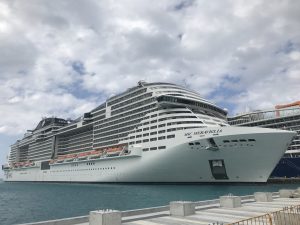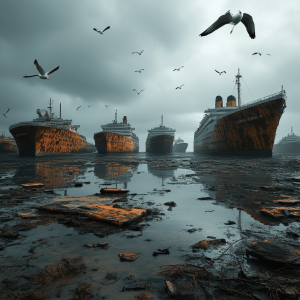Cruise ships, with their towering decks, luxurious amenities, and state-of-the-art technology, are marvels of modern engineering. Yet, like all machines, they have a finite lifespan. When their time at sea ends, these giants of the ocean embark on one last voyage—to the cruise ship graveyards. Let’s explore where and how cruise ships are dismantled and repurposed.
Click Here to Explore Upcoming Cruises and Book with Us!
The Lifecycle of a Cruise Ship

Cruise ships are typically built to last around 30 years. Over time, maintenance becomes more costly, and newer, more efficient ships replace the old ones. When a ship is no longer economically viable, the owners must decide its fate. This often leads to a trip to a shipbreaking yard.
The Major Shipbreaking Yards

1. Alang, India
Alang, located on the western coast of India, is the world’s largest shipbreaking yard. Here, hundreds of ships meet their end each year. The process is labor-intensive and often dangerous, but it provides valuable employment for thousands of workers. The ships are beached at high tide and then dismantled by hand, piece by piece. Alang’s shipbreaking industry recycles millions of tons of steel annually, which is then used in construction and manufacturing.
2. Chittagong, Bangladesh
Chittagong is another major hub for shipbreaking. The process here is similar to Alang, with ships being run aground and dismantled manually. Chittagong has faced criticism for its environmental and safety standards, but efforts are ongoing to improve conditions. Despite the challenges, the shipbreaking industry in Chittagong is a vital part of the local economy.
3. Gadani, Pakistan
Gadani, located on the coast of Pakistan, is the third-largest shipbreaking yard globally. The yard operates in much the same way as Alang and Chittagong, with ships being broken down to recover steel and other materials. Gadani has also been under scrutiny for safety and environmental practices, but it remains a significant player in the global shipbreaking industry.
Environmental and Safety Concerns
Shipbreaking is a hazardous industry. Workers are exposed to toxic substances like asbestos, lead, and heavy metals. The dismantling process can also lead to oil spills and other environmental hazards. International organizations, such as the International Maritime Organization (IMO), have developed guidelines and regulations to improve safety and environmental standards in shipbreaking yards.
The Role of Recycling
Despite the dangers, shipbreaking plays a crucial role in recycling. Steel recovered from ships is a valuable resource, reducing the need for new steel production, which is energy-intensive and polluting. Other materials, such as copper, aluminum, and plastics, are also recycled, contributing to a circular economy.
Innovations and Alternatives
As the industry faces increasing pressure to improve, innovations in shipbreaking are emerging. Some companies are exploring the use of robotics and automation to make the process safer and more efficient. Additionally, there are efforts to develop more sustainable methods of disposing of retired ships, such as sinking them to create artificial reefs.
The Future of Retired Cruise Ships
While shipbreaking will likely remain the primary method of disposing of retired cruise ships, the industry is evolving. Improved regulations, better safety standards, and innovations in recycling processes are making shipbreaking more sustainable. As the cruise industry grows, finding responsible ways to handle retired ships will become increasingly important.
Cruise ships spend decades offering unforgettable experiences to passengers. When their time comes to an end, they embark on one final journey to the shipbreaking yards. It’s a harsh but necessary process that ensures these giants of the sea continue to provide value, even in death.
For more insights into the fascinating world of cruise ships, check out these related stories:
- The Hidden World of Cruise Ship Graveyards
- What Happens to Cruise Ships When They Retire?
- Exploring the End of the Line for Cruise Ships
By understanding where and how cruise ships meet their end, we gain a deeper appreciation for the entire lifecycle of these maritime marvels. From their maiden voyage to their final dismantling, each phase of a cruise ship’s life is a testament to human ingenuity and the complex interplay of global industries.


